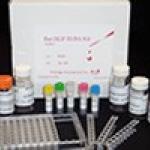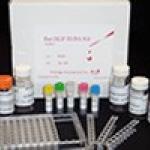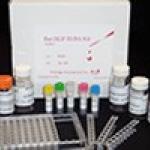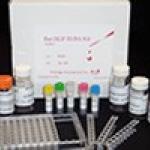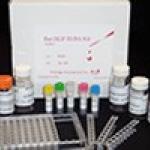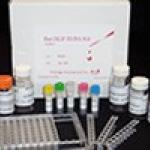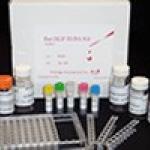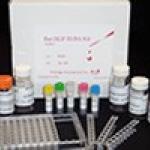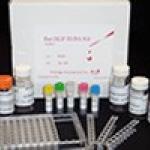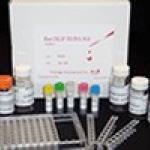-
Description:
Cystatin or cystatin 3 (formerly gamma trace, post-gamma-globulin or neuroendocrine basic polypeptide), a protein encoded by the CST3 gene, was originally described as a constituent of normal cerebrospinal fluid (CSF) and of urine from patients with renal failure.1 Cystatin 3 has a low molecular weight (approximately 13.3 kilodaltons…
-
Description:
Leptospirosis is an economically important zoonotic disease caused by a spirochaete bacteria of the genus Leptospira. Cattle-maintained leptospires of the serovar hardjo are the major cause of bovine leptospirosis1. This infection is responsible for considerable financial loss to the cattle industry as a consequence of agalactia,…
-
Description:
An enkephalin is a pentapeptide involved in regulating nociception in the body. The enkephlins are termed endogenous ligands, or specifically endorphins, as they are internally derived and bind to the body's opiod receptors. They function as neurotransmitters or neuromodulators and inhibit neurotransmitters in the pathway for pain…
-
Description:
Interleukin 23 receptor is a subunit of the receptor for IL23A/IL23. This protein pairs with the receptor molecule IL12RB1/IL12Rbeta1, and both are required for IL23A signaling.
This protein associates constitutively with Janus kinase 2 (JAK2), and also binds to transcription activator STAT3 in a ligand-dependent manner.Expressed by…
-
Description:
Luteinizing hormone (LH) is an important hormone of the reproductive system, which has found application in diagnosis and therapeutic medicine. It plays a vital role in the development and functioning of the reproductive system. Determination of LH concentration is important for detection of dysfunction of the pituitary variance axis…
-
Description:
LIFR also known as CD118 (Cluster of Differentiation 118), is a subunit of a receptor for leukemia inhibitory factor.
The leukemia inhibitory factor is a polyfunctional cytokine that affects the differentiation, survival, and proliferation of a wide variety of cells in the adult and the embryo. LIF action appears to be mediated…
-
Description:
The LPL (Lipoprotein Lipase) ELISA is an enzyme immunoassay intended for the quantitative determination of human LPL in Serum or Plasma. LPL is an enzyme that cleaves triglycerides for fatty acid uptake in the periphery. Determination of the LPL concentration might be a complementary measure for LPL activity.
-
Description:
Lipoxin A4 (LXA4) is a biologically active lipoxygenase interaction product derived from arachidonic acid. Arachidonic acid is first oxygenated by 15- lipoxygenase to form 15-HETE which is then converted by 5-lipoxygenase and epoxide hydrase to generate LXA4. LXA4 regulates leukocyte traffic, inhibiting neutrophils and stimulating…
-
Description:
Three types of LKM antibodies can be distinguished according to the target antigens. LKM-1 antibodies are directed against cytochrome p450 IID6, a 50 kDa cytoplasmic protein found in hepatocytes and renal proximal tubular cells. LKM-2 antibodies are associated with ticrynafen (tienilic acid) -induced hepatitis. The target antigen is…
-
Description:
Lactoferrin (LF), a globular multifunctional protein with antimicrobial activity (bacteriocide, fungicide), is part of the innate defense, mainly at mucoses. Lactoferrin is found in milk and many mucosal secretions such as tears and saliva. Lactoferrin is also present in secondary granules of PMN and also is secreted by some acinar…
 Description: Cystatin or cystatin 3 (formerly gamma trace, post-gamma-globulin or neuroendocrine basic polypeptide), a protein encoded by the CST3 gene, was originally described as a constituent of normal cerebrospinal fluid (CSF) and of urine from patients with renal failure.1 Cystatin 3 has a low molecular weight (approximately 13.3 kilodaltons…
Description: Cystatin or cystatin 3 (formerly gamma trace, post-gamma-globulin or neuroendocrine basic polypeptide), a protein encoded by the CST3 gene, was originally described as a constituent of normal cerebrospinal fluid (CSF) and of urine from patients with renal failure.1 Cystatin 3 has a low molecular weight (approximately 13.3 kilodaltons… Description: Leptospirosis is an economically important zoonotic disease caused by a spirochaete bacteria of the genus Leptospira. Cattle-maintained leptospires of the serovar hardjo are the major cause of bovine leptospirosis1. This infection is responsible for considerable financial loss to the cattle industry as a consequence of agalactia,…
Description: Leptospirosis is an economically important zoonotic disease caused by a spirochaete bacteria of the genus Leptospira. Cattle-maintained leptospires of the serovar hardjo are the major cause of bovine leptospirosis1. This infection is responsible for considerable financial loss to the cattle industry as a consequence of agalactia,… Description: An enkephalin is a pentapeptide involved in regulating nociception in the body. The enkephlins are termed endogenous ligands, or specifically endorphins, as they are internally derived and bind to the body's opiod receptors. They function as neurotransmitters or neuromodulators and inhibit neurotransmitters in the pathway for pain…
Description: An enkephalin is a pentapeptide involved in regulating nociception in the body. The enkephlins are termed endogenous ligands, or specifically endorphins, as they are internally derived and bind to the body's opiod receptors. They function as neurotransmitters or neuromodulators and inhibit neurotransmitters in the pathway for pain… Description: Interleukin 23 receptor is a subunit of the receptor for IL23A/IL23. This protein pairs with the receptor molecule IL12RB1/IL12Rbeta1, and both are required for IL23A signaling. This protein associates constitutively with Janus kinase 2 (JAK2), and also binds to transcription activator STAT3 in a ligand-dependent manner.Expressed by…
Description: Interleukin 23 receptor is a subunit of the receptor for IL23A/IL23. This protein pairs with the receptor molecule IL12RB1/IL12Rbeta1, and both are required for IL23A signaling. This protein associates constitutively with Janus kinase 2 (JAK2), and also binds to transcription activator STAT3 in a ligand-dependent manner.Expressed by… Description: Luteinizing hormone (LH) is an important hormone of the reproductive system, which has found application in diagnosis and therapeutic medicine. It plays a vital role in the development and functioning of the reproductive system. Determination of LH concentration is important for detection of dysfunction of the pituitary variance axis…
Description: Luteinizing hormone (LH) is an important hormone of the reproductive system, which has found application in diagnosis and therapeutic medicine. It plays a vital role in the development and functioning of the reproductive system. Determination of LH concentration is important for detection of dysfunction of the pituitary variance axis… Description: LIFR also known as CD118 (Cluster of Differentiation 118), is a subunit of a receptor for leukemia inhibitory factor. The leukemia inhibitory factor is a polyfunctional cytokine that affects the differentiation, survival, and proliferation of a wide variety of cells in the adult and the embryo. LIF action appears to be mediated…
Description: LIFR also known as CD118 (Cluster of Differentiation 118), is a subunit of a receptor for leukemia inhibitory factor. The leukemia inhibitory factor is a polyfunctional cytokine that affects the differentiation, survival, and proliferation of a wide variety of cells in the adult and the embryo. LIF action appears to be mediated… Description: The LPL (Lipoprotein Lipase) ELISA is an enzyme immunoassay intended for the quantitative determination of human LPL in Serum or Plasma. LPL is an enzyme that cleaves triglycerides for fatty acid uptake in the periphery. Determination of the LPL concentration might be a complementary measure for LPL activity.
Description: The LPL (Lipoprotein Lipase) ELISA is an enzyme immunoassay intended for the quantitative determination of human LPL in Serum or Plasma. LPL is an enzyme that cleaves triglycerides for fatty acid uptake in the periphery. Determination of the LPL concentration might be a complementary measure for LPL activity. Description: Lipoxin A4 (LXA4) is a biologically active lipoxygenase interaction product derived from arachidonic acid. Arachidonic acid is first oxygenated by 15- lipoxygenase to form 15-HETE which is then converted by 5-lipoxygenase and epoxide hydrase to generate LXA4. LXA4 regulates leukocyte traffic, inhibiting neutrophils and stimulating…
Description: Lipoxin A4 (LXA4) is a biologically active lipoxygenase interaction product derived from arachidonic acid. Arachidonic acid is first oxygenated by 15- lipoxygenase to form 15-HETE which is then converted by 5-lipoxygenase and epoxide hydrase to generate LXA4. LXA4 regulates leukocyte traffic, inhibiting neutrophils and stimulating… Description: Three types of LKM antibodies can be distinguished according to the target antigens. LKM-1 antibodies are directed against cytochrome p450 IID6, a 50 kDa cytoplasmic protein found in hepatocytes and renal proximal tubular cells. LKM-2 antibodies are associated with ticrynafen (tienilic acid) -induced hepatitis. The target antigen is…
Description: Three types of LKM antibodies can be distinguished according to the target antigens. LKM-1 antibodies are directed against cytochrome p450 IID6, a 50 kDa cytoplasmic protein found in hepatocytes and renal proximal tubular cells. LKM-2 antibodies are associated with ticrynafen (tienilic acid) -induced hepatitis. The target antigen is… Description: Lactoferrin (LF), a globular multifunctional protein with antimicrobial activity (bacteriocide, fungicide), is part of the innate defense, mainly at mucoses. Lactoferrin is found in milk and many mucosal secretions such as tears and saliva. Lactoferrin is also present in secondary granules of PMN and also is secreted by some acinar…
Description: Lactoferrin (LF), a globular multifunctional protein with antimicrobial activity (bacteriocide, fungicide), is part of the innate defense, mainly at mucoses. Lactoferrin is found in milk and many mucosal secretions such as tears and saliva. Lactoferrin is also present in secondary granules of PMN and also is secreted by some acinar…
